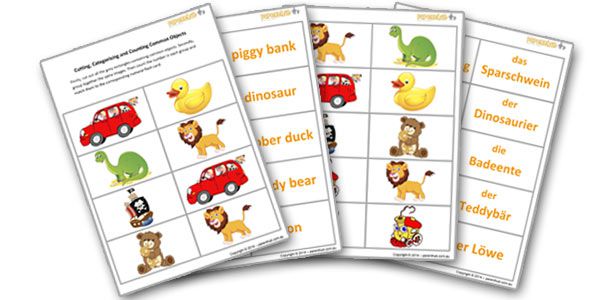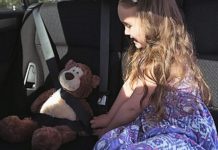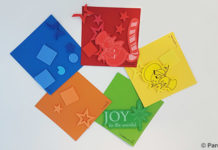Age
3-6 years
Duration of activity
Cutting out the common objects will take a child 15-30 minutes, depending on how well developed their cutting skills are. Playing sorting games with the object cut outs will probably take another 15-30 minutes.
Materials/equipment
- Common objects cut out worksheets
- Child safe scissors
- Number and/or common object label flashcards (depending on the activities you choose to play)
Cost
Printing the common objects cut-out worksheets will cost about $1.
Preparation
- To prepare for this activity print the Common Objects Cut Out worksheets and find a pair of child-safe scissors in the craft box.
What to do
Cutting out common objects
 Sit with your child and look at the cutting out activity sheets. Discuss the characteristics of the common objects pictured, for example their size, colour and shape. Compare the objects, for example talk about the differences between lions and fairies and the similarities between cars and trains.
Sit with your child and look at the cutting out activity sheets. Discuss the characteristics of the common objects pictured, for example their size, colour and shape. Compare the objects, for example talk about the differences between lions and fairies and the similarities between cars and trains.- Read the instructions at the top of the worksheet to your child, pointing to the words as you read to them. Encourage older children who are starting to read to have a go at reading for themselves and allow younger children to pretend they are reading even if they can’t. If your child does not properly understand what to do, further explain to them that they need to cut out all the boxes containing objects on the page. Tell them that they should try and stay as close to the lines as possible when they are doing the cutting. When they have finished cutting the objects out they will use them to play games.
- Ask your child to take the scissors and start cutting the first object out. Children generally develop the ability to cut straight lines and corners at around 4 years of age- if your child is four or younger you’ll probably need to give them a bit of help.
- When your child has finished cutting out the first object, ask them to continue cutting until all the objects on the page have been cut out.
Sorting, counting and matching numerals with objects
- This activity involves sorting the objects into groups, counting them and matching them to the correct number flashcard. You will also need a set of numeral flashcards to play this game.
- Line the numeral flashcards in order from 1-10. To make this a little more challenging for older children you could put them in reverse order from 10-1. For younger children who do not yet recognise the numerals, using dot flashcards and asking you to match the cards with the same number of dots and objects will make this easier.
- To begin, ask your child to choose one of the common objects- it doesn’t matter which one. When they have chosen it, ask them to talk about the object, for example to say its name and discuss who uses the object and what for.
- Next ask them to find all the other objects which are the same (e.g. all the lions, all the dinosaurs). Let them attempt this independently, but help them out if you notice they’ve missed one or more of the objects. For example you could say something like, “I can see another lion. Have another look and see if you can find another lion.”
- When your child has identified all the same objects, ask them to count the objects.
- When they have counted the objects and identified how many there are, ask them the place the group of objects next to the corresponding numeral. For example if they have just counted three pirate ships, they should then put them next to the numeral 3.
- Repeat until all the common objects have been sorted into groups and placed next to the correct numeral
Sorting, counting and labelling common objects
- This activity involves sorting the objects into groups, counting them and matching them to the correct common object label flashcard. You will also need a set of common object label flashcards to play this game.
- Lay the label flashcards in a row on the ground or on a table your child can reach.
- Follow the instructions for matching common objects with numerals, however match the object to the correct word label flashcard.
- Teach your child the numbers names of common objects in languages other than English using the multilingual flash cards.
- Encourage your child to sort the objects into different groups. For example they could make a group of all the animals, or one of all the objects that start with the letter b.
Tips
- Laminate the objects your child cuts out so you can continue using them over and over again.
- For older children who recognise all the numbers and understand the concept of odd and even numbers, make this a bit trickier by asking your child to put all the even numbers in ascending (and then in reverse order) and match them with the correct group of objects. Then do the same for the odd numbers.
- Teach your child to pronounce the number words using the number ‘word’ flashcards. Say each number word clearly, pointing at the letters as you pronounce different parts of the word. Then get your child to sound the words out themselves and match words with the correct group of objects.
- Use mathematical words like more and less to describe the groups of common objects, for example saying something like, “there are more trains than dinosaurs but less fairies than pirate ships.”
- Encourage your child as they play by offering congratulations if they try hard or get the correct answer and asking them to have another go if they make a mistake or don’t put much effort in. Help them out if they get stuck.
Extension activities
- Teach your child the numbers names of common objects in languages other than English using the multilingual flash cards.
- Encourage your child to sort the objects into different groups. For example they could make a group of all the animals, or one of all the objects that start with the letter b.
Educational outcomes
Mathematical skills
 Cutting, sorting and counting common object flashcards provides opportunities for your child to learn and practice a range of mathematical skills and concepts. They will be learning or improving their ability to recognise quantities and the symbols which represent them (numerals/numbers). These are fundamental mathematical skills, without which more complex concepts and skills like measurement and addition cannot be attained. Counting aloud is also an essential mathematical skill for preschool aged children to learn. Sorting is another important mathematical concept which children should have a basic understanding of before they start primary school. This activity will also help children develop their mathematical vocabulary and understanding of concepts like size. It provides numerous opportunities for them to use mathematical words like big and small or more and less, to describe characteristics of the common objects.
Cutting, sorting and counting common object flashcards provides opportunities for your child to learn and practice a range of mathematical skills and concepts. They will be learning or improving their ability to recognise quantities and the symbols which represent them (numerals/numbers). These are fundamental mathematical skills, without which more complex concepts and skills like measurement and addition cannot be attained. Counting aloud is also an essential mathematical skill for preschool aged children to learn. Sorting is another important mathematical concept which children should have a basic understanding of before they start primary school. This activity will also help children develop their mathematical vocabulary and understanding of concepts like size. It provides numerous opportunities for them to use mathematical words like big and small or more and less, to describe characteristics of the common objects.
Fine motor skills
Cutting with a pair of scissors is a great fine motor skill activity for children. From about three years of age they should be able to manipulate a pair of child-sized scissors well enough to make a few snips at the edge of the paper, but won’t yet have the control needed to cut around the boxes. They’ll probably also have an awkward scissor grasp and sometimes try to use the scissors with two hands. By about four years they’ll probably be able to hold the scissors correctly in one hand and cut neatly along the straight edges of the object boxes and around the corners. However they may leave a margin around the edge. Whether they make a few snips at the paper or cut everything out on their own, all the cutting they do will be working their finger muscles and gradually improving their cutting ability.
Children will also use and further develop their fine motor skills when they pick up the common object cut outs and flashcards. Encourage them to use pincer grip (only their thumb and forefinger) and pick them up carefully without crumpling the paper (similar to the way they would turn the page of a book without crumpling them). Demonstrate how to do this by picking up the flash cards and objects carefully yourself.
Communication and social skills
Communicating in everyday situations teaches young children skills they will use to communicate at school, at work and in social situations throughout their lives. When they talk and listen to you they be learning about the conventions of verbal communication, for example to take turns when speaking and to reply when they are asked a question. By three years of age most children should already be able to do things like answer when they are asked a question or follow simple instructions.
They also learn about non-verbal communication, for example how to use facial expressions, gestures and body language to communicate what they are feeling or talking about.
Speak clearly and use simple sentences as you communicate with your child. Compliment them when they communicate effectively to help develop their self-efficacy and make them feel good about themselves. If they make a mistake or do not communicate clearly, talk to them about what they could have done more effectively.
Language and literacy skills
 Talking throughout the activity will help children develop their language skills while reading instructions and label flashcards will help them develop their literacy skills. As you talk they’ll be hearing new words and learning how to join words together in sentences. Encourage them to try saying the new words they learn and experiment with combining words in sentences. By four years of age you’ll probably notice your child using more complex grammar when they speak, for example they’ll start putting words like ‘a’ or ‘the’ in front of nouns (e.g. saying, ‘the dog” instead of pointing and saying dog).
Talking throughout the activity will help children develop their language skills while reading instructions and label flashcards will help them develop their literacy skills. As you talk they’ll be hearing new words and learning how to join words together in sentences. Encourage them to try saying the new words they learn and experiment with combining words in sentences. By four years of age you’ll probably notice your child using more complex grammar when they speak, for example they’ll start putting words like ‘a’ or ‘the’ in front of nouns (e.g. saying, ‘the dog” instead of pointing and saying dog).
As they read instructions or labels they’ll be getting practice recognising the letters of the alphabet and saying the corresponding sounds. They’ll also become aware of the different parts of text, for example that sentences are units of speech. Pointing at the words and letters will help reinforce literacy concepts, for example that text is read from left to right and that letter symbols represent sounds. Three year olds probably won’t be able to read yet but will enjoy pretending they’re reading. Four year olds will be able to recognise some simple and familiar words but will need your help reading more complex words. By the end of their sixth year children should recognise all the letters of the alphabet and be familiar with their common sounds. They’ll be learning that letters sometimes make different sounds when combined with other letters.
If you use multilingual flashcards you’ll be helping your child learn the basics of a second language. You’ll also be making them aware that English is one of many languages spoken in Australia and the world, an awareness children should develop by 5-6 years of age.
Flashcard and worksheet downloads
- Common objects cut out worksheets
- Common objects flashcard labels
- Numeral flashcards
- Dot flashcards
References
- Virginia Early Childhood Development Alignment Program. Milestones of child development- A guide to young children’s learning and development from birth to kindergarten. 2009. (cited 21 May 2014). Available from: (URL Link)
- Joseph GE, Strain PS. Building Positive Relationships with Young Children. Vandebuilt University- The Centre for the Social and Emotional Foundations for Early Learning. (cited 21 May 2014). Available from: (URL Link)
- Andrews M. General Categories of Fine Motor Development. Michigan State University Extension. UNDATED. (cited 21 May 2014). Available from: (URL Link)
- Australian Curriculum and Reporting Authority. Australian Curriculum- English. Undated. (cited 2 October 2013) Available from: (URL Link)



 (10 votes, average: 4.60 out of 5)
(10 votes, average: 4.60 out of 5) 






